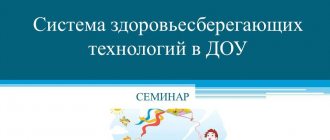Conducting self-analysis
Self-analysis should include the following points:
- target;
- tasks;
- Preparation;
- communication part;
- physical education.
Teachers must be competent
It is imperative to include a person-centered approach.
At the end - summing up.
The analysis includes:
- Subject.
- Date and number of the group in which the event is being held.
- Target.
- Justification for the choice of topic from the point of view of psychology, i.e. must correspond to the general goals and objectives, the context of the topic being studied.
- Observation. This point includes checking how well the goals and objectives of the hour are revealed to the children, whether it encourages the pupils to do any activity, whether it is possible to measure intermediate results, and whether the pupils have drawn conclusions.
- Degree of controllability. How the lesson affected relationships in the group, how the children began to respond to art.
- General assessment of the event. Conclusions are drawn on psychological and pedagogical topics in relation to the teacher and students.
Note! In the process of work, the teacher must take into account the character characteristics of each child.
There are requirements for educators
Methodological aspects
In a preschool institution, goals and methods are established by the state program.
Stages of the method:
- Vocabulary, in the form of a conversation.
- Illustrating. Illustrations on the assigned topic.
- Practical. Modeling of figures related to the theme.
- During the game stage, didactic games on a general topic are used. This process includes a physical education aspect in the form of gymnastics for the fingers and eyes.
- Motivating and rewarding techniques are included.
- It is mandatory to include assessment and control of children’s personal actions and work.
Additional Information! When self-analysis, it is necessary to take into account that information should be presented in the form of a game, involving children in joint activities.
How is the procedure performed?
For correct self-assessment, you should initially decide on the purpose of the lesson. It should be clear and include the initiative of teachers to show educational achievements and innovations in raising children in the older or younger group. Another goal is to show the preparatory level of the teacher in a particular preschool institution.
Using analysis, you can check the following:
- children's readiness for school;
- compliance of the structure and techniques used with state standards;
- the teacher’s ability to interact with children;
- sense of time;
- control of voice timbre and intonation;
- the ability to create the necessary emotional background in a group.
Teachers must be qualified
As a result, shortcomings are identified or their absence is noted.
How the analysis is carried out:
- You are required to write down the age of the children and their number in the group.
- Mark the topics and targets.
- Describe the structure of the lesson, i.e. describe in detail the stages and each action.
- Study in detail the techniques used, describing the objects and theoretical materials used.
- Assess the level of organization and effectiveness of the event. This assessment includes the logic of construction, the speed of the lesson and the teacher’s speech, the emotional level, independence and activity of the children.
- At the end, inaccuracies are assessed and ways to eliminate them are proposed.
Preparing a 6-year-old child for school at home
Additional Information! As a result, the teacher offers an independent assessment of the work done, based on the children’s answers and the general emotional background of the group.
Stages of self-assessment
Self-analysis is a person’s independent assessment of his actions and judgments. The teacher needs to evaluate the children's behavior, the accuracy of their actions and their effectiveness in relation to their goals.
Stages of self-analysis:
- Characteristics of students in the group - number and age.
- The degree of compliance of the selected program with the general system of education standards.
- Checking the logic and validity of tasks and goals.
- Availability of didactic materials on the topic. Using music based on the theme, listening to classical melodies to depict natural features with the arrival of spring.
- Structure of the lesson. There are main stages. They are logically connected and smoothly transition from one to another. Each stage prepares children for the next. The time between them is distributed logically and used profitably. The lesson lasts no longer than 25 minutes. Children do not get tired because there is a change in activity, from exercises for speech development to games or drawing, etc.
- The atmosphere of the event. Pupils need to be interested, that is, in the process it is necessary to offer children a poetic form of speech and some surprises.
- It is necessary to determine speech and other activities and behavior. It is worth considering how many times and who was active, why the rest were passive, how other participants worked, what inspired them to act. The assessment is given only to the quality of the child’s actions, and not to the character or personality traits. Determine the form of children’s work in class: with a team, in a separate group, separately.
- Features of the teacher's actions. The presence of contact perception with children, speech characteristics (tempo, intonation and logic).
- Results. The achievement of goals and objectives, the degree to which the plan and tasks are completed by children are noted. The effectiveness of the techniques and methods used, the thoughtfulness of the presentation of the material. What was not realized from the plans set, and how to achieve this.
Note! Training should include a scientific aspect, a problem side, i.e., highlight weak points in children’s knowledge, clarity, a cognitive part, be understandable, systematic and step-by-step. The program must remain relevant without changing the overall goals and objectives. Federal standardization includes developmental and educational functions.
Activities and games for cognitive development in younger groups
Relevance
Monitoring allows you to identify strengths and weaknesses in the educational program of a preschool institution.
Relevance:
- To determine the success and effectiveness of the learning process.
- To train teachers (speech therapists, educators, etc.) to independently analyze and evaluate the dynamics of their work in education.
- Self-analysis of a correctly conducted lesson in kindergarten helps to carry out appropriate management of the state of the educational process.
- Makes it possible to predict the prospects for the development of objects or subjects of learning.
Important! The analysis should reveal the existence of conditions for joint partnership activities between children and adults.
Self-analysis of an open lesson should be carried out with an independent approach




